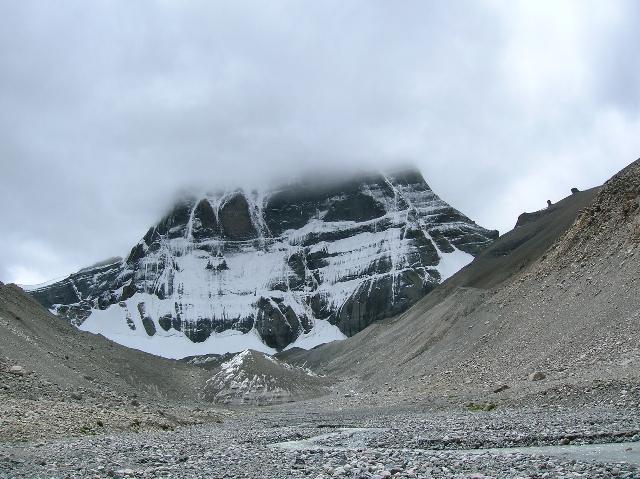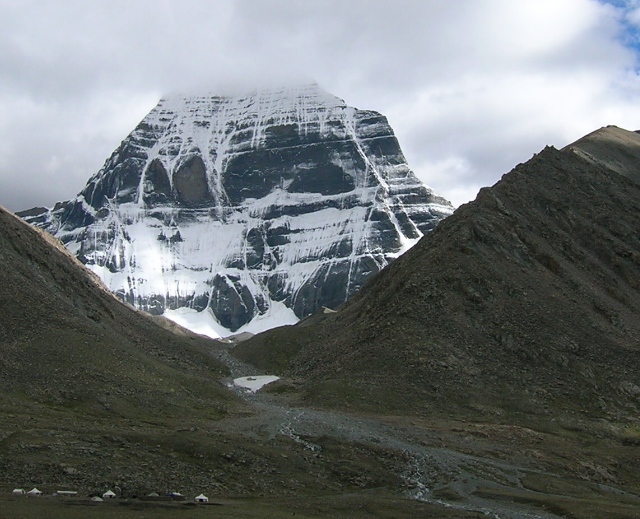|
Prelude
Day 1: Arrival in Lhasa
Day 2: Sera Monastery
Day 3: Bumpari Mountain
Day 4: Urban Kora
Day 5: Drepung Monastery
Day 6: Potala Palace Kora
Day 7: Gyaphelri Mountain
Day 8: Preparations for Kailas
Day 9: Gyantse
Day 10: Tashilungpo Monastery
Day 11: Lhatse
Day 12: Saga
Day 13: Pariyang
Day 14: Darchen
Day 15: Dirapuk Monastery
Day 16: The Glacier
Day 17: Dzutrulpuk Monastery
Day 18: Lake Mansarovar
Day 19: Return to Saga
Day 20: Nyalam
Day 21: Return to Lhatse
Day 22: Lhasa 2.0
Coda
|
Day 16: The Glacier
We will sleep here at the monastery again tonight (the first and only time in the whole trip that we sleep in the same place for two nights.)
We get up relatively late and go up to the monastery kitchen. The nuns slave away on their knees in the dirt in dirty and ragged street clothes, cooking, boiling water, churning the yak-butter tea maker, tending the yak-dung fire, washing the dishes, and scrubbing the pots. The monks sit around in fine robes eating and drinking tea - they might be persuaded to pass the hot water but that's all. Everyone seems to regard this division of labor as completely normal.
All the meals that the nuns make here (mostly noodle soups) contain fresh green vegetables from the monastery's greenhouse. The greenhouse faces South, of course, is walled with stone, and covered with plastic sheeting. At over 16,000 feet, this has to be the world's highest greenhouse, and it seems to be productive enough to feed half a dozen people with ease. Tending it, of course, falls to the nuns.
The Chinese have a saying that 'Women hold up half the sky': these women seem to be holding up pretty much all of it.
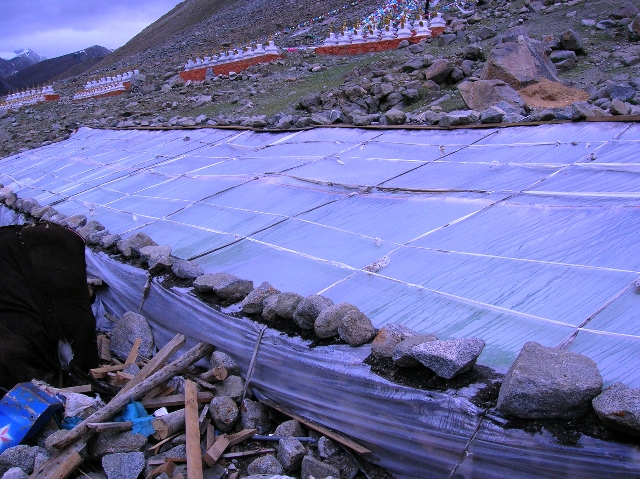 | Dirapuk Monastery Greenhouse |
I am keen to get up close with Kailas, crossing the valley and walking up the streambed to the base of the glacier streaming down from Kailas' North face. The Swiss want to take it easy and have some couple time together, which doesn't surprise me too much. I am surprised, however, when even Pablo is less than enthusiastic. Pablo is an academic, specializing in geopolitics and very involved in the struggles of rural and oppressed populations in India and Nepal. He is very knowledgeable about Hindu mythology, and connected to the myths of Shiva and Parvati that take place on this mountain. The central place that this mountain occupies in the mythology of India and Nepal plays a major part in his motivation for the pilgrimage.
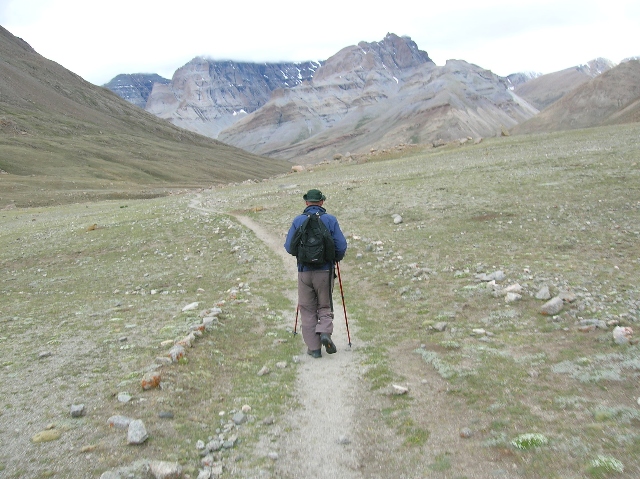 | Pablo Setting Out for the Glacier |
Pablo accompanies me for the first half-mile or so, but turns back just before the bridge. He is probably thinking about the tough day we have tomorrow. I walk up a small side valley to the point where it connects with the valley coming down from the glacier, and am just thinking what an easy and pleasant walk this is when I realize that I left my walking pole behind twenty minutes back when I took a drink from the stream. The valley loses some, though not all, of its charm when walked for the second and third times.
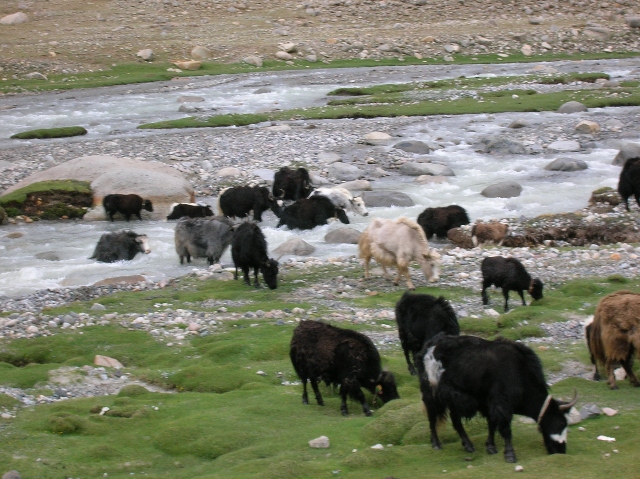 | Yaks Crossing the River Near Dirapuk |
The walk up to the glacier is pleasant and fun when done as a day trip. You could probably do it at the end of the first day out from Darchen as well, but only if you were in good shape and got an early start. There's some interesting rock-hopping to be done to cross the stream, and earlier in the season the snow patches might present a little challenge, but the gradient is easy and the view, of course, gets better with every step.
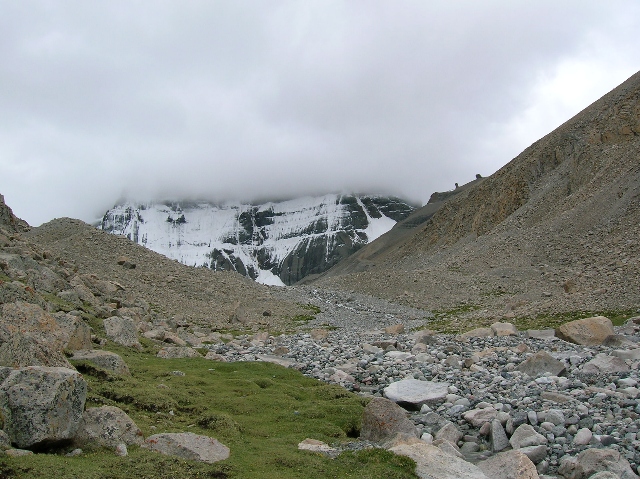 | Approach to the Glacier |
At around the 17,000 foot level the vegetation changes, the grass giving way to a variety of extremely unusual plants that I have never seen before. They almost seem to be made of ice, and feel frozen to the touch. They are so hardy that they remain abundant all the way up to the foot of the glacier.
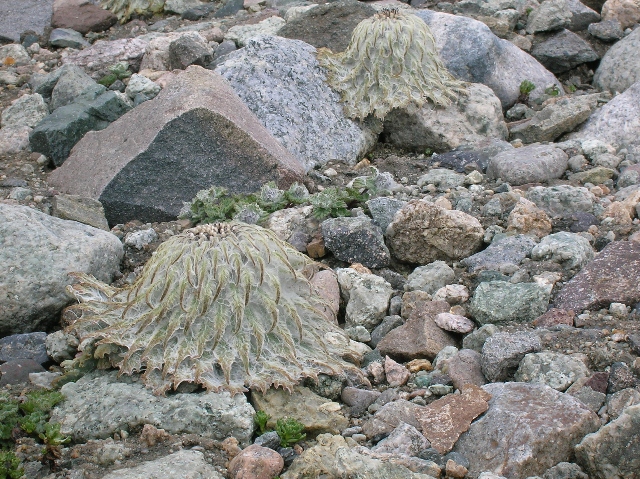 | Strange Ice-Plant |
The valley leads up to a stony plateau and a wall of ice.
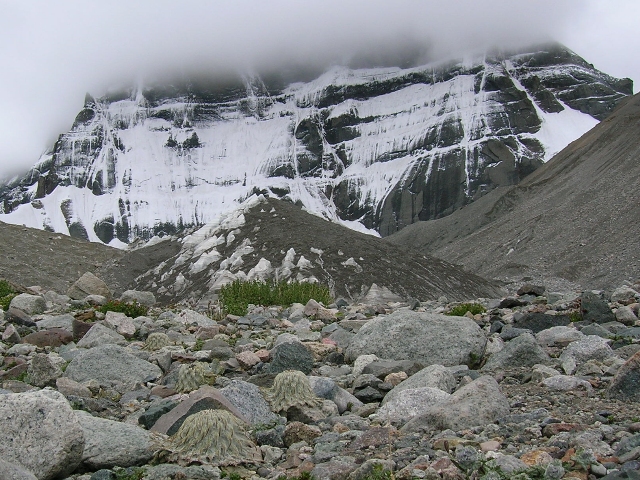 | Glacier with Trees and Strange Plants in Foreground |
 | The Glacier |
In front of the ice wall is a small improvised altar to Shiva, to which I make some equally improvised offerings.
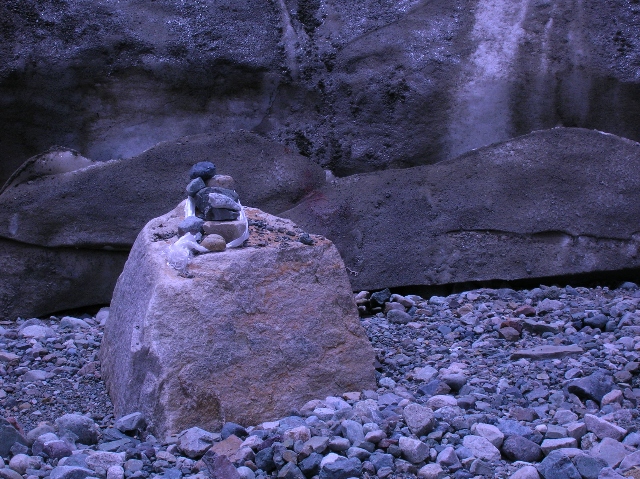 | Altar to Shiva at the Ice Wall |
To the right of the ice wall is a rocky gully that seems to lead right up to the foot of Kailas' towering North Face. After some thought I decide not to take it. The moraine looks somewhat unstable, and this would be a bad place to break a leg or even twist an ankle, but that isn't my reason. I am in the presence of gods and I don't want to try their patience.
 | Moraine Leading to Kailas's North Face |
As I return the cloud-skirt over Kailas keeps flirtatiously rising and falling, teasing but never revealing.
Dirapuk Monastery is visible through the notch in the valley. Perhaps this is why the monastery is sited where it is.
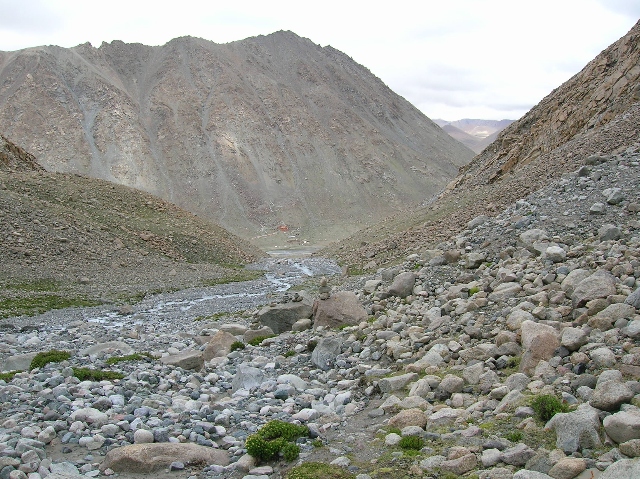 | Dirapuk Seen from the Glacier Valley |
The best views doesn't come till I am almost back to the river.
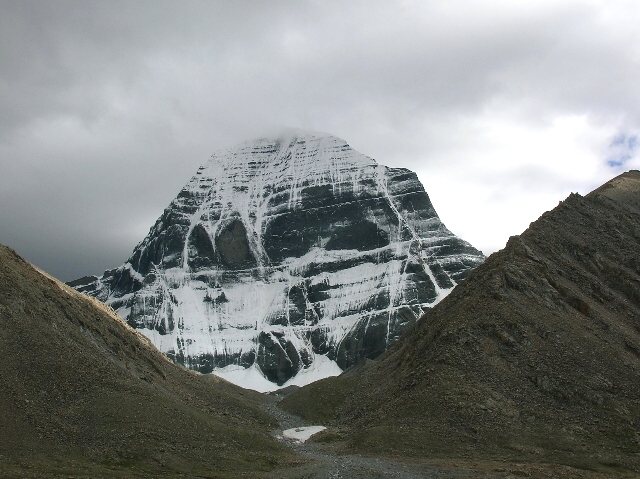 | Clearest Views of Mount Kailas |
I cross the river by the other bridge this time (the one we will take tomorrow on our way to Drolma La).
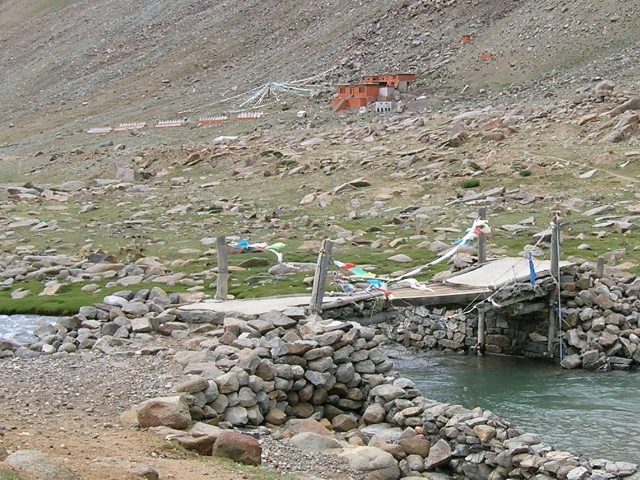 | East Bridge to Dirapuk |
In my absence the five-year-old daughter of one of our porters has 'adopted' a baby goat and made friends with one of the young monks.
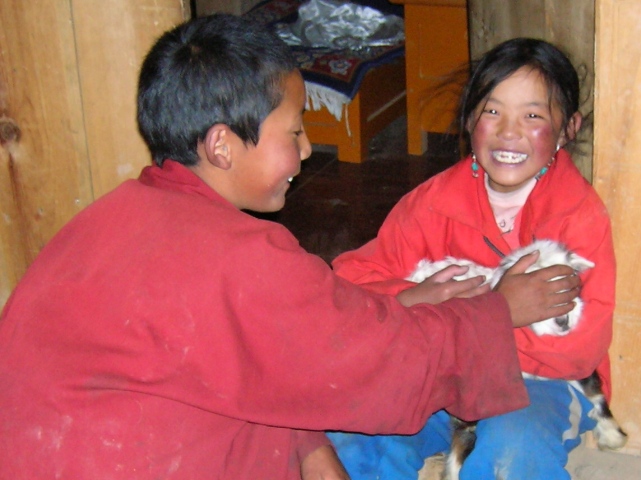 | Guide with Young Monk Friend and Baby Kid |
Down in the valley teams of workers are working furiously to finish some new accommodations for pilgrims before winter comes.
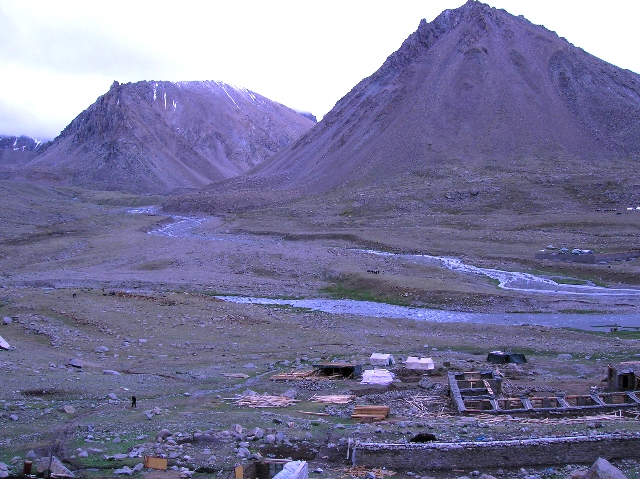 | Building Work Below Dirapuk |
Pablo is a fairly serious photographer and is in search of the perfect, cloud-free photo of Kailas, what he refers to as the 'money shot' (a term of course normally associated with the world of video porn). The closest we get to a money shot comes just as the sun is setting:
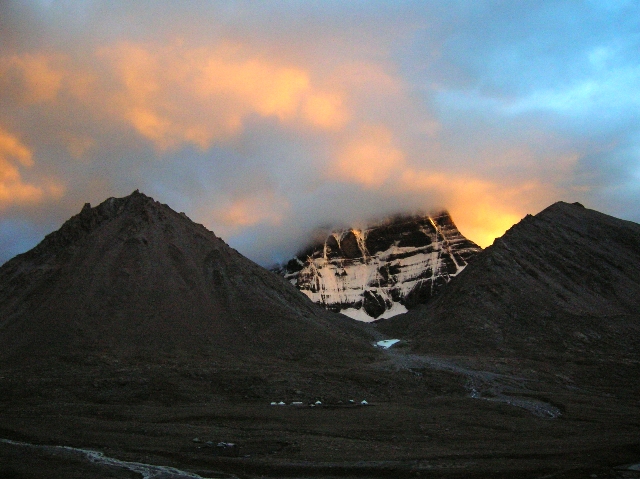 | Money Shot(?) |
In the evening we meet Roger, the organizer (if that's not too strong a word) of our tour (if you can really call it that), in the monastery kitchen. He is guiding another, pricy, full-service tour around the mountain. His group are camped down by the river, but he has left them to their own devices for the evening because he personally would rather be up here in the monastery. His appearance is even more wild than my own (I hope!), and he has an intense three-quarters-mad thousand-yard stare in his eyes. He is planning to make it around the mountain fifteen times this year if his body holds up. On the way here we were wondering if we should try and contact him about our transportation problems, but as soon as we see him we realize that nothing could interest him less - he doesn't even care about the group he is guiding, why would he care about us? All he cares about is the mountain and enlightenment. Roger doesn't give a shit even more profoundly than Rene of Shigatse Travel, but I like him far better. If I were to run a business, this is how I would probably do it, unfortunately.
The nuns are still scurrying about serving all of us: my half-hearted offers to help are brushed away. This small detail clinches a feeling that has been growing on me for some time - that the Tibetans would do well to get down on their knees every morning and thank the Chinese for liberating them from a backward and oppressive feudal society. I say this of course with all sympathy for the many innocent victims of the Chinese revolution, and with all respect for everyone's right to their own cultural identity and religious practice.
I learned a while ago that most Tibetans are racist, in the low-key, almost unnoticeable
ethnocentric style that enables Thais, for example, to quietly oppress the hill tribes on their Northern border. That the Tibetans are not currently oppressing anyone is not due to any virtue on their part but to their lack of power over others. They're not personally to blame - it's not a lifestyle choice, it's what a thousand years of insular feudalism instills in you. It's a racism without obvious external trappings - no lynchings or burning crosses - but that doesn't make it harmless. Now I'm being exposed to their sexism as well.
I decided I decided quite some time back that, much as I admire the Dalai Lama personally, I could no longer support his restoration as ruler of Tibet. These people may mean well but they have too many blind spots from their feudal history. How would they treat the Chinese inhabitants of Tibet? Mass deportations?
Next Page
|









